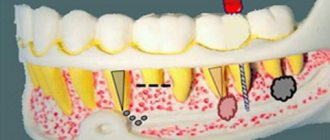Allergic laryngeal edema is a pathological condition characterized by inflammation of the mucous tissues of the larynx and narrowing of its lumen (stenosis). It occurs due to the body’s contact with factors hostile to it – allergens.
Author:
- Sadykhov Rahim Agalarovich
ENT pathology expert
2.45 (Votes: 38)
Allergic laryngeal edema is a pathological condition characterized by inflammation of the mucous tissues of the larynx and narrowing of its lumen (stenosis). It occurs due to the body’s contact with factors hostile to it – allergens, which cause a negative immune reaction. The main danger of edema is depression of respiratory function. As the lumen of the larynx narrows, breathing becomes difficult, which provokes oxygen deficiency, which is life-threatening.
Causes of swelling
Laryngeal edema occurs as a response of the body to an allergen irritant. This reaction is individual - under the same conditions, the same stimulus can cause a serious condition in one person, but not affect another in any way. It depends on the characteristics of the immune system.
Allergens may be the following:
- medications, especially when administered intravenously and intramuscularly;
- pet hair;
- insect bites;
- fungi, mold;
- food (often nuts, milk, eggs, fish, some vegetables, fruits);
- chemical substances;
- dust, pollen.
Itchy nose, sneezing, stuffiness
One of the most common manifestations of a cold is a runny nose, which is formed when viruses or microbes penetrate the surface of the mucous membranes. The development of a runny nose is a staged process; initially, during the initial contact of pathogens with the mucous membranes, their dryness and irritation are formed, which is manifested by a feeling of discomfort when breathing, burning or dryness, itching in the nose. Sneezing, associated with irritation of the nasal receptors, can also occur with severe itching. The sensation of itching occurs as a result of irritation of receptors; you can read more about it on the website - https://medaboutme.ru/zdorove/spravochnik/slovar-medicinskih-terminov/zud/. As the process progresses, edema and swelling of the mucous membranes develop, itching and dryness are replaced by copious and clear nasal discharge. Against this background, swelling of the mucous membranes forms, nasal breathing becomes very difficult, and malaise occurs. Due to mucus draining into the throat, coughing or coughing may occur.
Types of allergic laryngeal edema
There are acute and chronic allergic edema.
Acute allergic edema
In this case, you must call emergency assistance. Difficulty breathing is obvious and sudden, the condition is rapidly deteriorating. A person breathes intermittently and frequently; the muscles of the shoulders, head and back are involved in breathing, the supraclavicular fossae are sunken, and the intercostal spaces are drawn in. The skin turns pale, blue, the pulse increases, and the patient may begin to panic. In the absence of medical assistance, the lumen of the larynx closes completely, which causes asphyxia and death.
Before the arrival of medical workers, those close to the patient should be advised by telephone what to do. Emergency tips for breathing problems:
- interrupt the person’s contact with the substance that caused such a reaction (if this can be determined);
- in case of food poisoning, rinse the stomach;
- free a person from being squeezed by clothing;
- provide a flow of fresh air;
- give an antihistamine.
Chronic allergic edema
In this case, discomfort in the throat and breathing problems occur periodically, without getting worse, but giving the person very unpleasant sensations. This condition is a consequence of certain diseases or systematic contact with an allergen (for example, mold or animal hair in the house). Its symptoms are as follows:
- swelling and redness of the tonsils, uvula and palate;
- difficulty inhaling more than exhaling;
- rapid breathing;
- dyspnea;
- sensation of a foreign body in the throat;
- inability to exercise due to worsening breathing problems.
If you have these symptoms, be sure to consult an otolaryngologist to cure the underlying disease or remove the allergen from your environment.
Chronic allergic edema of the larynx is dangerous because it can sharply and suddenly develop into Quincke's edema - when the increase in clinical manifestations occurs within a few minutes. Quincke's edema is characterized by severe swelling of the neck and face and can spread to the mucous membrane of the larynx, causing severe stenosis. If signs of Quincke's edema appear, you should urgently call an ambulance.
In cases of chronic allergies, the person is usually aware of their condition and should always keep antihistamines on hand to stop the progression of the condition. Such drugs are prescribed by the doctor individually - there are different types of antihistamines, and it is important to choose the ones that suit you.
Non-infectious causes of itching
One of the reasons for a sore throat may be an allergic reaction of the body to a certain irritant - an allergen. This could be pollen, pet hair and excretions, dust, etc. With allergies, a sore throat is accompanied by watery eyes, sneezing, runny nose, itching in the eyes and nose. As a rule, allergies appear almost immediately after contact with the allergen.
The appearance of discomfort and scratching in the throat can be caused by swallowing solid food, which injures the mucous membrane of the larynx.
One of the dangerous manifestations of itching in the larynx is Quincke's edema. In this condition, swelling of the neck and face is observed. In the absence of qualified assistance, a person’s respiratory tract can be completely blocked, which will lead to death.
If diseases of the ENT organs have not been diagnosed, but the problem remains, it is worth being examined by a gastroenterologist. There are diseases of the gastrointestinal tract in which the contents of the stomach are thrown back into the esophagus, which causes discomfort in the throat. Such diagnoses include gastroesophageal reflux disease, gastritis, and ulcers.
Sometimes the pharynx itches due to tumors of the thyroid gland, which, growing and squeezing the neck, affect the receptors on the mucous membrane of the pharynx and cause itching.
It happens that such a condition is associated with neurological disorders, for example, with neurosis or paralysis of the pharyngeal nerves. In this case, you cannot do without consulting a neurologist.
Only a qualified doctor after a diagnosis can determine the true cause of the symptom and suggest how to treat severe itching in the throat.
Diagnosis and treatment
At the appointment, the doctor collects anamnesis, examines and palpates the larynx. If necessary, bronchoscopy and laryngoscopy procedures, X-rays, and computed tomography are performed.
Allergic swelling of the larynx is treated with medication or surgery. Medicines include antihistamines, which suppress the action of histamine, and glucocorticosteroids, which block the inflammatory response and swelling and suppress the immunological response to the allergen. Surgical intervention is a tracheostomy, an emergency measure when a person is at immediate risk of suffocation - inserting a breathing tube into the trachea through a small incision in the throat.
Diseases of the ENT organs that occur with itching in the throat
Irritation of the mucous membrane of the oropharyngeal area, characterized by itching, soreness, and coughing, is characteristic of the following diseases:
- Allergic pharyngitis
- Chronic laryngotracheitis
- Hay fever
- Mycoses
- Acute respiratory infections
The structure of the ENT organs: the connection of the structures of this system with each other allows pathogenic agents to “migrate” from one organ to another, causing damage to the entire system.
Allergens, penetrating with a current of air into the nasal cavity and spreading to all parts of the oropharynx, can cause rhinitis, pharyngitis, tracheitis, occurring with tissue swelling, itching, and soreness.
Fungal infections of the mucous membranes of the ENT organs, including the pharyngeal region, cause inflammatory phenomena that occur with rapid growth of fungal mycelium. One of the signs of such an infection is an itchy throat.
Chronic diseases of the upper respiratory tract lead to dry mucous membranes, with foci of atrophy, fragility of capillaries and are characterized by itching in the throat, dryness, and soreness.
Prevention
As preventative measures, as well as after an attack, it is recommended:
- strengthen immunity;
- perform moderate physical activity;
- use halotherapy and climatotherapy (stay at sea and in the mountains);
- use air purifiers;
- adhere to a diet excluding highly allergenic foods and products containing preservatives and chemical additives.
If you are concerned about breathing problems of any kind, we are always ready to provide assistance, make the correct diagnosis and begin treatment immediately. Call and make an appointment at the Ear, Nose and Throat Clinic!
Diseases of internal organs accompanied by itching in the throat
Many pathologies of the endocrine system, gastrointestinal tract, neurological pathologies, in addition to the main symptoms, can provoke itching in the throat:
- Diabetes mellitus is a common cause of itching of the mucous membranes and skin.
- One of the diagnostic symptoms of inflammatory diseases of the esophagus, stomach, and gallbladder is itching and soreness in the throat in the morning.
- New growths of the thyroid gland (cysts, tumors) can provoke itching sensations in the pharyngeal area.
- Osteochondrosis of the cervical vertebrae can be accompanied by numbness in the mouth and pharynx and occur with itching.
- Neurosis of the pharyngeal region involves the ear in the affected area, causing tingling, itching, and a sensation of a lump in the throat.
Main symptoms of the disease:
- pain, itching, dryness;
- sensation of a lump or foreign body in the throat;
- swelling of the mucous membranes of the throat and pharynx;
- attacks of coughing and sneezing;
- nasal congestion (runny nose);
- discharge of mucous formations from the oropharynx;
- itching in the eyes (especially when combined with conjunctivitis), sore throat, nasal passages;
- the back wall of the larynx becomes red or even purple;
- weakening of the voice (hoarseness, hoarseness);
- feeling of “heat” in the throat area.
Fever is an uncharacteristic sign of the disease, which usually indicates the addition of a secondary infection.
The pathology is considered dangerous due to the possibility of pharyngitis turning into otitis media, sinusitis, and tonsillitis. Otolaryngologists at MedicCity, using the most advanced treatment methods and modern equipment, will be able to diagnose, treat you and relieve you of unpleasant symptoms. Don't develop allergic pharyngitis and don't let it ruin your life!
The acute form occurs with long-term or short-term exposure to allergens on the body. It usually goes away quickly. The long course of the disease and possible complications appear with prolonged contact with allergens. Inflammation can affect not only the throat, but also the respiratory tract, as well as the entire body.
Diagnosis of red throat
To identify the cause of a red throat, the patient must consult an otorhinolaryngologist (ENT) or therapist.
If a child has a red throat, a pediatrician’s consultation is necessary.
To identify lesions of the oropharynx, certain rules must be followed. First of all, the inspection requires sufficient lighting (fluorescent lamp, frontal reflector, etc.). The doctor carefully collects anamnesis to make the correct diagnosis.
An otorhinolaryngologist may prescribe a consultation with other specialists: a gastroenterologist, a dentist, and others.
Various laboratory tests are performed: bacteriological examination (culture from the back of the throat and tonsils and PCR), blood tests (complete blood count, ESR, C-reactive protein).
Sore throat, dry cough
Often, a cold, along with damage to the nasal mucosa, is also accompanied by damage to the pharynx and the development of pharyngitis. This is an acute inflammatory process in the area of the palatine arches and the back wall of the pharynx, leading to an unpleasant burning sensation and irritation, pain when swallowing with a sore throat. Because of such sensations, a sick person begins to cough or cough heavily, this is due to irritation of receptors in the mucous membranes against the background of damage and inflammation. You can read more about sore throat on the website - https://medaboutme.ru/zdorove/spravochnik/slovar-medicinskih-terminov/pershenie_v_gorle/. This problem can be dealt with using various techniques. This includes humidifying the air and regular ventilation, taking warm liquids that increase blood flow to the mucous membranes and reduce their irritation. The use of inhalations with saline or mineral water, sprays to relieve dryness and sore throat, and lozenges with emollient and anti-inflammatory components are also indicated.
Usually, against the background of local symptoms - runny nose and sore throat, cough, a set of general symptoms is also typical, such as malaise, weakness, a feeling of drowsiness or weakness, which is associated with the influence of viruses or microbes and their metabolic products on the body. Due to the tension of the immune system and the activation of protective mechanisms during a cold, a fever occurs, the main purpose of which is to suppress the activity of viruses and stimulate metabolism to eliminate colds. If the condition is relatively normal and the temperature is well tolerated, there is no need to lower it; it is important that due to it the body launches protective factors and helps in quickly eliminating viruses from the body. As the condition improves and the pathogen is controlled, the temperature decreases and local symptoms also decrease.











